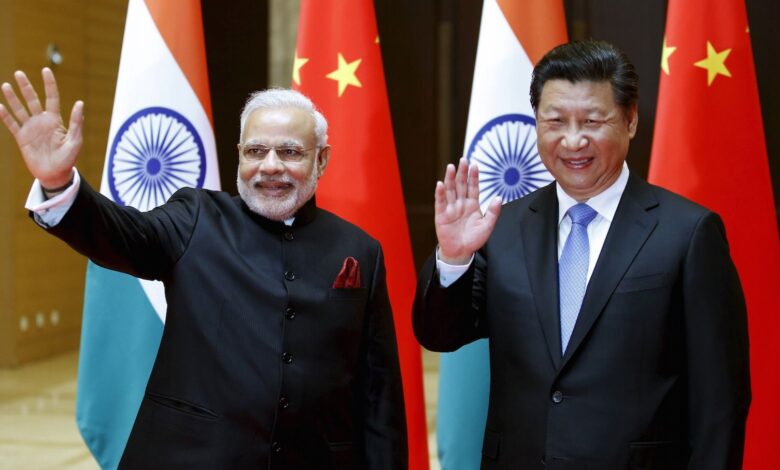India-China relations and the possibility of the new world order
Chinese Ambassador Xu Feihong’s remarks that China will firmly stand with India to uphold the multilateral trading system, with the WTO at its core, come against the backdrop of the ongoing tariff dispute between the United States and India and wider global geopolitical frictions.

• If managed effectively, India–China collaboration could help stabilize global growth amid rising protectionism, technological disruptions, and shifting power balances. Their cooperation would also give the Global South greater bargaining power in international negotiations, providing an alternative to Western-dominated frameworks.
During a recent visit to India, Chinese Ambassador Xu Feihong stated, “China will firmly stand with India to uphold the multilateral trading system, with the WTO at its core.” His remarks, and their broader symbolism, come against the backdrop of the ongoing tariff dispute between the United States and India, alongside wider global geopolitical frictions.
The meeting highlighted China’s show of support for India in the face of Washington’s 50 percent tariff, with Beijing openly criticizing the U.S. stance as heavy-handed. While the move was seen by some as an unexpected gesture that could mark a turning point in India-China relations, analysts of international affairs caution against overstatement. They note that Beijing’s position is more reflective of a gradual, deliberate effort by both countries to improve ties since 2024, rather than a sudden policy shift.
India and China have taken significant steps to normalize relations after years of strain. On the military front, both sides reached an agreement in October 2024 to end the four-year-long stalemate at the Line of Actual Control (LAC). This was followed in January 2025 by an agreement in principle to resume direct air services, signaling renewed commitment to restoring mutual trust and addressing outstanding trade and economic issues.
The resumption of dialogue has been accompanied by a more optimistic tone in official statements. Prime Minister Narendra Modi has emphasized “respect for each other’s interests and sensitivities,” while the Chinese foreign ministry has underlined the need for “trust and support” in pursuit of a “steady development track” in bilateral relations.
During a recent visit to India, Chinese Ambassador Xu Feihong reiterated Beijing’s opposition to steep tariffs imposed by the United States on Indian goods, describing Washington as a “bully” that uses tariffs as bargaining chips. He argued that the U.S. position undermines free trade, noting that India had acted in self-interest by importing discounted Russian crude oil to shield millions of citizens from rising energy costs.
The ambassador’s remarks coincided with Chinese Foreign Minister Wang Yi’s two-day visit to Delhi, which served as more than just a reaction to U.S. tariff aggression. His meetings created a platform for broad diplomatic engagement and prepared the ground for Prime Minister Modi’s upcoming visit to China later this year, his first since 2018.
In discussions with India’s National Security Advisor Ajit Doval, Wang Yi stressed that New Delhi and Beijing should regard each other as “partners, not adversaries.” He highlighted progress in restoring stability along the border, noting that recent setbacks had harmed both sides. This acknowledgment underscores the importance of addressing security issues that have hindered cooperation and contributed to mistrust.
Indian External Affairs Minister S. Jaishankar also underlined the importance of shaping a “fair, balanced, and multipolar world order.” His call for “reformed multilateralism and a multipolar Asia” reflected New Delhi’s determination to reduce dependence on traditional Western power centers and to work with Beijing in strengthening global governance structures.
Experts argue that the tariff dispute and the relative decline of U.S. presence in Indo-Pacific partnerships provide an opportunity for India and China to accelerate reconciliation. Both nations, often described as “double engines” of Asian growth, have the potential to create new economic opportunities not only for themselves but also for the broader Global South.
The latest round of talks has already produced tangible outcomes. Both countries agreed to facilitate trade and investment, with Indian enterprises invited to operate in China under fair and non-discriminatory conditions, while Chinese companies seek similar assurances in India. The two sides also agreed to reopen border trade through Lipulekh Pass, Shipki La Pass, and Nathu La Pass—routes with historic significance for cross-border commerce.
Additionally, the discussions reaffirmed their shared commitment to multilateralism, pledging to uphold the WTO-centered trading system, enhance dialogue on international and regional issues, and promote a multipolar world that safeguards the interests of developing countries.
The scope for trade expansion between the two economies is vast. According to the Indian Council for Research on International Economic Relations (ICRIER), India’s untapped export potential to China is estimated at $161 billion, nearly ten times the current level. Much of this lies in medium- and high-tech sectors, including telecommunications equipment, aircraft parts, motor vehicle components, and semiconductors. Diversifying into these sectors could significantly alter the trade balance.
Policy experts suggest creating a joint India–China task force to address tariff and non-tariff barriers, increase transparency in testing and certification, and ensure WTO-compliant practices. Encouraging targeted Chinese investment in India’s Production-Linked Incentive (PLI) sectors—such as electronics, automobiles, and pharmaceuticals—would strengthen supply chains and accelerate technology transfer.
Beyond economics, the strategic implications of cooperation are far-reaching. Stronger bilateral ties could reshape Asia’s geopolitical architecture by reducing external interference in regional disputes and creating new Asia-led trade blocs. For both countries, trust-building is key. Sustained partnership requires mutual respect for sovereignty, economic priorities, and geopolitical concerns.
If managed effectively, India–China collaboration could help stabilize global growth amid rising protectionism, technological disruptions, and shifting power balances. Their cooperation would also give the Global South greater bargaining power in international negotiations, providing an alternative to Western-dominated frameworks.
The vision of a “Dragon-Elephant tango” symbolizes this potential—a partnership rooted in trade, technology, and security cooperation. By reconciling past disputes and prioritizing shared interests, India and China could lay the foundation for a new Asian order characterized by multipolarity, equitable global governance, and peaceful conflict resolution.
Such a development would not only benefit both nations but also revolutionize the broader Asia-Pacific landscape. With coordinated action, they could drive an era of cooperation that strengthens regional autonomy and ensures that global systems evolve to reflect the realities of the 21st century.
In essence, the evolving dialogue between India and China represents more than temporary alignment against U.S. tariffs. It signals a deeper recalibration of bilateral relations, offering both nations—and the wider Global South—an opportunity to shape a multipolar world order that better reflects their shared aspirations and economic weight.













